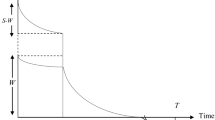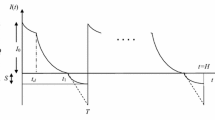Abstract
This model illustrates an inventory model to obtain retailer’s optimal replenishment policy for deteriorating items with fixed lifetime, shortages, and time dependent backorder rate. The backorder rate is assumed as a decreasing function of waiting time up to the next replenishment. The aim is to minimize the total relevant cost of the system. The necessary and sufficient conditions are derived analytically. Some lemmas are established for the existence and uniqueness of optimal solution. Finally, some numerical examples, sensitivity analysis, comparison with other models, study of non-considering lifetime of products along with graphical representations are provided to illustrate the proposed model. From the numerical example, this model proves more savings than Wu et al. (Int J Prod Econ 101:369–384, 2006).






Similar content being viewed by others
References
Ghare PM, Schrader GF (1963) A model for exponentially decaying inventory system. Int J Prod Res 21:449–460
Covert RP, Philip GC (1973) An EOQ model for items with Weibull distribution deterioration. AIIE Tran 5:323–326
Balkhi ZT, Benkherouf L (2004) On an inventory model for deteriorating items with stock dependent and time-varying demand rates. Comput Oper Res 31:223–240
Chung CJ, Wee HM (2007) Scheduling and replenishment plan for an integrated deteriorating inventory model with stock-dependent selling rate. Int J Adv Manuf Tech 35:665–679
Hsu PH, Wee HM, Teng HM (2010) Preservation technology investment for deteriorating inventory. Int J Prod Eco 124:388–394
Widyadana GA, Cárdenas-Barrón LE, Wee HM (2011) Economics order quantity model for deteriorating items with planned backorder level. Math Comput Model 54:1569–1575
Giri BC, Jalan AK, Chaudhuri KS (2003) Economic order quantity model with Weibull deterioration distribution, shortage and ramp-type demand. Int J Syst Sci 34:237–243
Manna S, Chaudhuri KS (2006) An EOQ model with ramp type demand rate, time dependent deterioration rate, unit production cost and shortages. Eur J Oper Res 171:557–566
Sana SS (2010) Optimal selling price and lotsize with time varying deterioration and partial backlogging. Appl Math Comput 217:185–194
Sett BK, Sarkar B, Goswami A (2012) A two-warehouse inventory model with increasing demand and time varying deterioration. Sci Iran 19:1969–1977
Sarkar B (2012) An EOQ model with delay in payments and time varying demand. Math Comput Model 55:367–377
Sarkar B (2013) A production-inventory model with probabilistic deterioration in two echelon supply chain management. Appl Math Model 37:3138–3151
Sarkar B, Sarkar M (2013) An economic manufacturing quantity model with probabilistic deterioration in a production system. Eco Model 31:245–252
Cárdenas-Barrón LE (2001) The economic production quantity (EPQ) with shortage derived algebraically. Int J Prod Eco 70:289–292
Cárdenas-Barrón LE (2007) On optimal manufacturing batch size with rework process at single-stage production system. Comput Ind Eng 53:196–198
Cárdenas-Barrón LE (2008) Optimal manufacturing batch size with rework in a single-stage production system—a simple derivation. Comput Ind Eng 55:758–765
Cárdenas-Barrón LE (2009a) On optimal batch sizing in a multi-stage production system with rework consideration. Eur J Oper Res 196:1238–1244
Cárdenas-Barrón LE (2009) Economic production quantity with rework process at a single-stage manufacturing system with planned backorders. Comput Ind Eng 57:1105–1113
Cárdenas-Barrón LE (2010) Optimal order size to take advantage of a one-time discount offer with allowed backorders. Appl Math Model 34:1642–1652
Cárdenas-Barrón LE (2011) The derivation of EOQ/EPQ inventory models with two backorders costs using analytic geometry and algebra. Appl Math Model 35:2394–2407
Cárdenas-Barrón LE (2012) A complement to a comprehensive note on: an economic order quantity with imperfect quality and quantity discounts. Appl Math Model 36:6338–6340
Sarkar B (2012) An inventory model with reliability in an imperfect production process. Appl Math Comput 218:4881–4891
Cárdenas-Barrón LE, Taleizadeh AA, Treviño-Garza G (2012) An improved solution to replenishment lot size problem with discontinuous issuing policy and rework, and the multi-delivery policy into economic production lot size problem with partial rework. Exp Syst Appl 39:13540–13546
Wee HM, Wang WT (2012) A supplement to the EPQ with partial backordering and phase-dependent backordering rate. Omega 40:264–266
Balakrishnan A, Pungburn MS, Stavrulaki E (2004) “Stack them high, let’em fly”: lot-sizing policies when inventories stimulate demand. Manag Sci 50:630–644
Wu KS, Ouyang LY, Yang CT (2006) An optimal replenishment policy for non-instantaneous deteriorating items with stock-dependent demand and partial backlogging. Int J Prod Econ 101:369–384
Hou KL (2006) An inventory model for deteriorating items with stock-dependent consumption rate and shortages under inflation and time discounting. Eur J Oper Res 168:463–474
Alfares HK (2007) Inventory model with stock-level dependent demand rate and variable holding cost. Int J Prod Eco 108:259–265
Sarkar B, Sana SS, Chaudhuri KS (2010) A stock-dependent inventory model in an imperfect production process. Int J Proc Manag 3:361–378
Sarkar B, Sana SS, Chaudhuri KS (2010) Optimal reliability, production lot size and safety stock in an imperfect production system. Int J Math Oper Res 2:467–490
Sarkar B, Sana SS, Chaudhuri KS (2011) An imperfect-production process for time varying demand with inflation and time value of money. Exp Syst Appl 38:13543–13548
Sarkar B, Sarkar S (2013) Variable deterioration and demand—an inventory model. Econ Model 31:548–556
Sarkar B, Mandal P, Sarkar S (2014) An EMQ model with price and time dependent demand under the effect of reliability and inflation. Appl Math Comput 231:414–421
Sarkar B, Sarkar S (2013) An improved inventory model with partial backlogging, time varying deterioration and stock-dependent demand. Econ Model 30:924–932
Sarkar B, Seth BK, Goswami A, Sarkar S (2015) Mitigation of high-tech products with probabilistic deterioration and inflations. Am J Ind Bus Manag 5:73–89
Sarkar B, Mandal B, Sarkar S (2015) Quality improvement and backorder price discount under controllable lead time in an inventory model. J Manuf Syst 35:2636
Sarkar B, Moon I (2014) Improved quality, setup cost reduction, and variable backorder costs in an imperfect production process. Int J Prod Econ 155:204–13
Acknowledgments
The authors like to thank two referees for their encouragement and valuable comments to improve the previous version of this paper. This study was financially supported by 2012 Post-Doctoral Development Program, Pusan National University, Korea.
Conflict of interest
There is no conflict of interest with the research area with all authors. 1st author has received his financial support from Post-Doctoral Development Program, Pusan National University, Korea, 2012. 2nd and 3rd author have not received any fund for this research.
Author information
Authors and Affiliations
Corresponding author
Appendices
Appendix A
Appendix B
Rights and permissions
About this article
Cite this article
Sarkar, B., Sarkar, S. & Yun, W.Y. Retailer’s optimal strategy for fixed lifetime products. Int. J. Mach. Learn. & Cyber. 7, 121–133 (2016). https://doi.org/10.1007/s13042-015-0393-y
Received:
Accepted:
Published:
Issue Date:
DOI: https://doi.org/10.1007/s13042-015-0393-y




